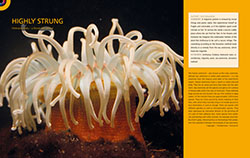INVERTEBRATES - Spectrum of Homeopathy 03/2021
The comparison between the evolution in the natural kingdoms and the psychological developmental stages of humans has not only led in recent years to a better understanding of the homeopathic materia medica but also put the focus on remedy groups associated with the initial phase of plant and animal development. As a counterpart to the ancient plants “Mosses and Ferns” (SPECTRUM 2/2021) we now present the invertebrates group, which is the origin of the animal world – indeed the oldest representatives of this group are easy to confuse with plants.
Very different remedies from this group, such as Spongia, Medusa or Helix tosta share particular characteristics that can point us to the invertebrates during casetaking. Ghanshyam Kalathia and his Indian colleagues Yamini Ramesh, Atul Padwardhan and Ganeshwara Rao have collated the common themes of this very heterogeneous group and demonstrate their practical use with a series of cases. For the further differentiation into animal phyla such as sponges, molluscs, echinoderms, the repertorised symptoms are used along with the relevant developmental stage of the patients and similarities to behavioural biology at the sensation level.
Some authors use Mahesh Gandhi’s Personal Evolution Model (PEM) in order to assign the individual patient’s developmental stage to a specific evolutionary stage in the animal kingdom. This method helps Iris Philippsen in the prescription of Crangon.
The intuitiveness and clarity of the world of animals in our patients’ experience and style of expression is vividly illustrated by Jonathan Hardy’s cases of remedies from the three classes of the molluscs. Here there is a description of both the fear of the mussel’s protective shell being chiselled open as well as the feeling of contentment experienced by the rolled-up snail in its little sphere. Hardy demonstrates in a masterful way how – with the help of the sensation method – one moves from determining the animal kingdom via the invertebrates to the various classes of mollusc. The remedy choice is then so well focused that the precise remedy can often be determined with just a few symptoms. For this final step the application of the sensation method and the observation of the developmental stages need to be supplemented and confirmed by remedy knowledge from proving and clinical practice.
It is therefore especially important that we keep on proving remedies according to the method pioneered by Hahnemann. So we are pleased in this issue to describe the classical homeopathic path from remedy proving via clinical practice, focusing on the remedies from the invertebrates group. The provings are 15 to 20 years old so that the authors have since been able to gather valuable experience with the practical application. So Jutta Hettkamp’s knowledge of the proving of lugworm enables her to reliably recognise in her patients needing Arenicola maritima the familiar feeling of being beside oneself and “not quite there” yet full of energy.
So the common characteristics of the invertebrates – their primitiveness and vulnerability, rendering them in need of protection and dependent on support – can be seen in the members of each animal class in a unique way – in the physical symptoms as well as on the psychological level and in the modes of life. Patterns like the evolution model and the personal experience at the sensation level can help us, in combination with repertorised symptoms, to differentiate this very heterogeneous remedy group. This means that primitive animals such as molluscs or Cnidaria can be securely distinguished more easily than mosses or ferns. Whereas we often scarcely register these ancient plants in nature, the colourful and varied world of the invertebrates impresses us far more directly with its multifarious manifestations.

Reading Sample